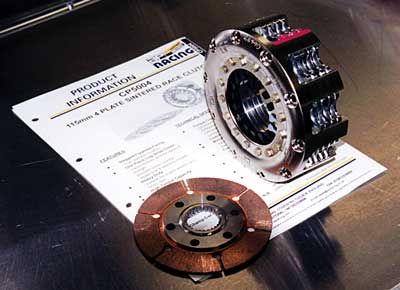INSIDE
RACING
T E C H N O L O G Y
IRT Home
News Page
Contents Page
Newsletter &
Books
email Paul
AP Clutches in CART Cars

Motorsports Spares also sells clutches, both AP and Tilton. This a four-plate, 4.5 inch diameter clutch as used in most CART cars. Rules say no carbon material or titanium can be used. The driving plates are mounted in the body. That's a clutch disk lying on the paper. A vendor brazes the sintered friction material onto a core disk made by AP. The clutch body bolts to the engine flywheel. There is a driven disc behind each plate. A throughout bearing pushes on the spring fingers you can barely see inside the opening in the body clamping the plates onto the discs. Internal splines carry forces from each clutch disk to the gearbox input shaft. Total travel to disengage all plates and discs is just over 3mm or an eighth of an inch.
Simon Ellis, race engineer for AP Racing of Coventry, England told me the history of racing clutches, "In 1955 we made a coil-spring 7 1/4 inch diam. clutch for the D Jaguars that won Le Mans. Diaphragm springs as used today started in 1967 with on a 7 1/4 clutch. In 1986 we made a 7 1/4, 2-plate unit for the 1.5 liter, turbocharged Formula 1 engines. The diameter went down to 5.5 inches in 1987 or '88. Then to 5.0 in '94. The ultra-small Toyota engine used a 4.5 inch clutch first in 1994. All the CART engines use it now. They want the engine to be able to sit low in the car and we can't let the clutch limit that. IRL engines have a longer stroke but they still would like to have a low moment of inertia clutch. They use either a 5.5 or 4.5 inch clutch."
"The engine manufacturers specify the clutch but the teams have a say in what they buy," Simon explained. "Higher clamping forces mean higher thrust forces on the crankshaft. Some drivers use the clutch to shift and some don't. The Reynard chassis come with hydraulic actuation but the Ganassi team converts to a cable. Lola and Swift use a cable. Slave cylinder knock-back at high engine rpm is a problem with an hydraulic actuator. The driver might have to pump the clutch pedal to work the clutch after a long stint on track."
The photo below is Simon Ellis talking to Lola designer, Ben Bowlby at Homestead during CART Spring Training. Guys like Simon take responsibility for critical racing components and are a tremendous resource for designers like Ben and for the race teams.
